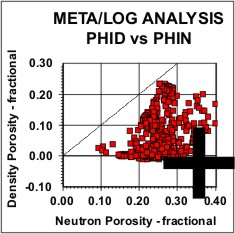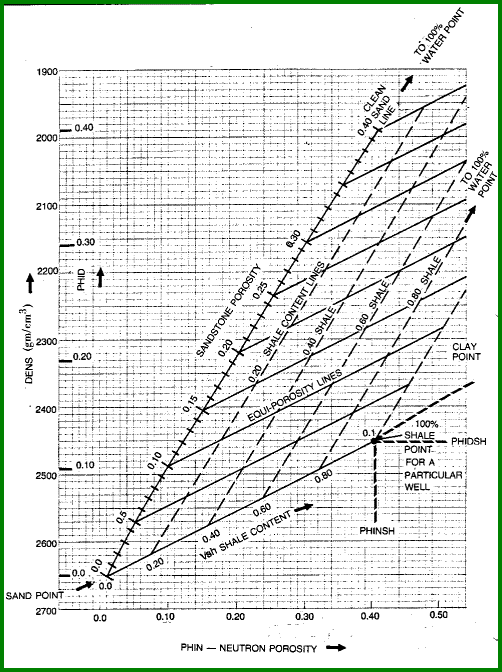|
 Shale Volume from Density Neutron Crossplot
Shale Volume from Density Neutron Crossplot
The
separation between neutron and density porosity is a common method
for calculating shale volume. It is accurate only when the shaly
sand contains pure quartz plus clay minerals. Most sandstones are
not pure quartz. When other minerals are present, some of the
separation is due to these minerals. Micas, siderite, ankerite, and
volcanic rock fragments are common in many sandstones. All are
heavier than quartz, causing the excess separation by reducing
density porosity and increasing neutron porosity.
The response equation for the density log in porosity units
follows the classical form:
1:
PHID = PHIe * Sxo * PHIDw (water term)
+ PHIe * (1 - Sxo) * PHIDh (hydrocarbon term)
+ Vsh * PHIDsh (shale term)
+ (1 - Vsh - PHIe) * Sum (Vi * PHIDi) (matrix term)
Where:
PHIDh = log reading in 100% hydrocarbon
PHIDi = log reading in 100% of the ith component of matrix
rock
PHID = log reading
PHIDsh = log reading in 100% shale
PHIDw = log reading in 100% water
PHIe = effective porosity (fractional)
Sxo = water saturation in invaded zone (fractional)
Vi = volume of ith component of matrix rock
Vsh = volume of shale (fractional)
The
response equation for the neutron porosity log also follows
the classical form:
2:
PHIN = PHIe * Sxo * PHINw (water term)
+ PHIe * (1 - Sxo) * PHINh (hydrocarbon term)
+ Vsh * PHINsh (shale term)
+ (1 - Vsh - PHIe) * Sum (Vi * PHINi) (matrix term)
Where:
PHINh = log reading in 100% hydrocarbon
PHINi = log reading in 100% of the ith component of matrix
rock
PHIN = log reading
PHINsh = log reading in 100% shale
PHINw = log reading in 100% water
PHIe = effective porosity (fractional)
Sxo = water saturation in invaded zone (fractional)
Vi = volume of ith component of matrix rock
Vsh = volume of shale (fractional)
 Shale Content from Density Neutron
Shale Content from Density Neutron
The
following assumptions are made:
PHIDw = PHIDh = PHINw = PHINh = 1.0, PHIDi = PHINi = 0.0.
Sxo = 1.0
Then
by subtracting the two equations and solving for Vsh, we
get:
3:
VSHxnd = (PHIN - PHID) / (PHINSH - PHIDSH)
4: VSHxnd = Min(1, Max(0, VSHxnd))
Thus,
the algebraic formula to solve for shale volume from the
density neutron crossplot is a linear interpolation of the
separation between the density and neutron porosity log
curves.
5: VSHxnd = (PHIN - PHID) / (PHINSH - PHIDSH)
Where:
PHID = density log porosity reading in zone of interest
(fractional)
PHIDSH = apparent density porosity in shale (fractional)
PHIN = neutron log reading in zone of interest fractional)
PHINSH = neutron log reading in 100% shale (fractional)
VSHxnd = shale volume from density neutron crossplot (fractional)
 COMMENTS:
COMMENTS:
Shale volume from the density neutron crossplot should only
be attempted in oil or water bearing shaly sands, not in
dolomite, anhydrite, or gas zones. This is because the separation
between the two curves is not a function of shale in these
cases. The density neutron will help resolve shale volume
in radioactive sands (like granite wash formations) provided
the zone is known to be sandstone. It will not help resolve
a radioactive dolomite.
 If
the density neutron data is recorded in percentage units
instead of fractional units, convert the data to fractions
by dividing each value by 100. If percentage data is used
in error, the results will still be correct, but Vsh will
be in fractional units. If
the density neutron data is recorded in percentage units
instead of fractional units, convert the data to fractions
by dividing each value by 100. If percentage data is used
in error, the results will still be correct, but Vsh will
be in fractional units.
 RECOMMENDED
PARAMETERS:
RECOMMENDED
PARAMETERS:
Range Default
PHIDSH -0.03 to +0.10 0.00
PHINSH 0.10 to 0.40 0.30
Choose from crossplot or depth plot.
 NUMERICAL
EXAMPLE:
NUMERICAL
EXAMPLE:
Assume PHID = 0.12, PHIN = 0.28, PHIDSH =
0.03, PHINSH = 0.30
Vsh from density neutron crossplot:
VSHxnd = (0.28 - 0.12) / (0.30 - 0.03) = 0.59
 Shale Content from Density Neutron with Matrix Offset
Shale Content from Density Neutron with Matrix Offset
The
previous method described for density neutron data assumes the clean line for the crossplot is identical
to the units of the density neutron log (i.e. sandstone
or limestone). If you wish the clean line to be at a matrix
value other than that for the log units, both neutron and
density data must be shifted to account for this matrix
change.
A
chart illustrating the construction of the shale content
lines on a density neutron crossplot is given below. This is the normal density neutron crossplot for determination
of porosity and shale volume in the shaly sand model when
the sand fraction is made up of pure quartz.

Shale Volume from Density Neutron Crossplot
A
matrix offset is needed if the sand contains heavy minerals
in place of some or all of the quartz. The matrix offset
translates the origin along a 45 degree line for CNL data,
and at a steeper angle for SNP data. This is equivalent
to the solution of the two response equations described
earlier, with PHIDi and PHINi not equal to zero, but determined
from knowledge of the actual rock description.
Reconstitute density
data from density porosity log.
6: DENS = PHID * KD1 + (1 - PHID) *
KD2
Where:
KD1 = 1.00 gm/cc English units 1000 kg/m3 Metric Units
KD2 = 2.65 gm/cc English units 2650 kg/m3 Metric Units
Calculate
density porosity for desired matrix and fluid values.
7: PHIDm = (DENSMA - DENS) / (DENSMA - DENSW)
Calculate
density offset for this matrix and fluid.
8: D = PHIDm - PHID
Calculate
neutron offset for same matrix.
9: C = KN4 * D
Where:
KN4 = 1.00 for CNL 0.75 for SNP neutron log
Calculate
neutron log reading for same matrix.
10: PHINm = PHIN - C
Adjust
shale values for offset
11: PHIDSHm = PHIDSH + D
12: PHINSHm = PHINSH - C
Calculate
shale content.
13: VSHxm = (PHINm - PHIDm) / (PHINSHm - PHIDSHm)
14: VSHxm = Min(1, Max(0, VSHxm))
Where:
C = neutron log offset (fractional)
D = density log offset (fractional)
DENS = density log reading (kg/m3 or gm/cc)
PHID = density log reading (fractional)
PHIDm = density log reading in zone of interest (fractional)
PHIDSH = apparent density porosity in shale (fractional)
PHIDSHm = density log reading in 100% shale in zone of interest
(fractional)
PHIN = neutron log reading in zone of interest (fractional)
PHINm = neutron log reading correction for matrix offset
(fractional)
PHINSH = neutron log reading in 100% shale fractional)
PHINSHm = neutron log reading in 100% shale corrected for
matrix offset (fractional)
DENSMA = matrix density (kg/m3 or gm/cc)
DENSW = fluid density (kg/m3 or gm/cc)
VSHxm = shale volume from density neutron crossplot corrected
for matrix offset (fractional)
 COMMENTS:
COMMENTS:
If density log is in density units, skip Step 1.
 RECOMMENDED
PARAMETERS:
RECOMMENDED
PARAMETERS:
Range Default
PHIDSH -0.03 to +0.10 0.00
PHINSH 0.10 to 0.40 0.30
 NUMERICAL
EXAMPLE:
NUMERICAL
EXAMPLE:
Using data for Sand "D".
PHID = 0.12
PHIDSH = 0.03
PHIN = 0.28
PHINSH = 0.30
Units = Sandstone
Desired DENSMA = 2740 kg/m3
DENS = (0.12 * 1000 + (1 - 0.12) * (2650)) = 2452
kg/m3
PHIDm = (2740 - 2452) / (2740 - 1000) = 0.165
D = 0.165 - 0.12 = + 0.045
C = - 0.045
PHINm = 0.28 - 0.045 = 0.235
PHIDSHm = 0.03 + 0.045 = 0.075
PHINSHm = 0.30 - 0.045 = 0.255
VSHxm = (0.235 - 0.165) / (0.233 = 0.075) = 0.39
This
result agrees more closely with GR and SP data and suggests
the matrix offset was reasonable and necessary. The value
with no offset applied was 0.59 from the previous example.
|

